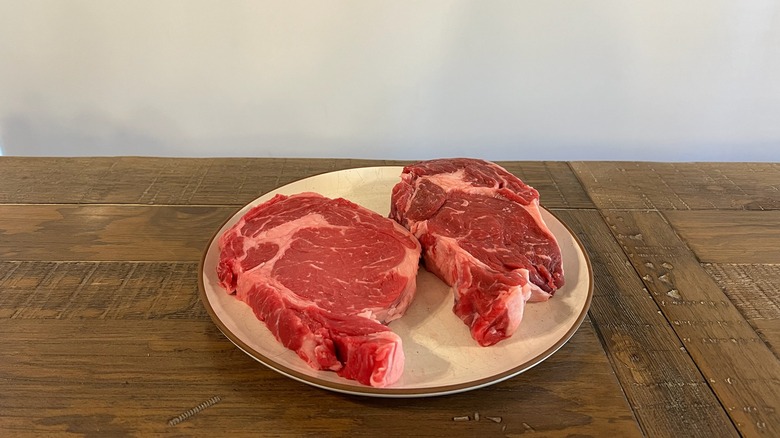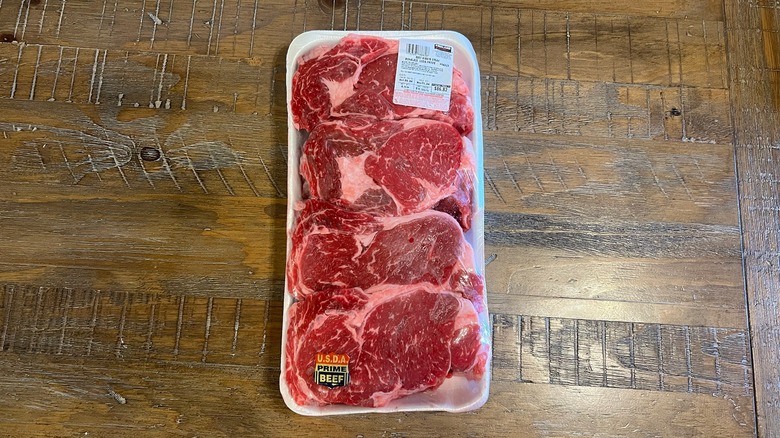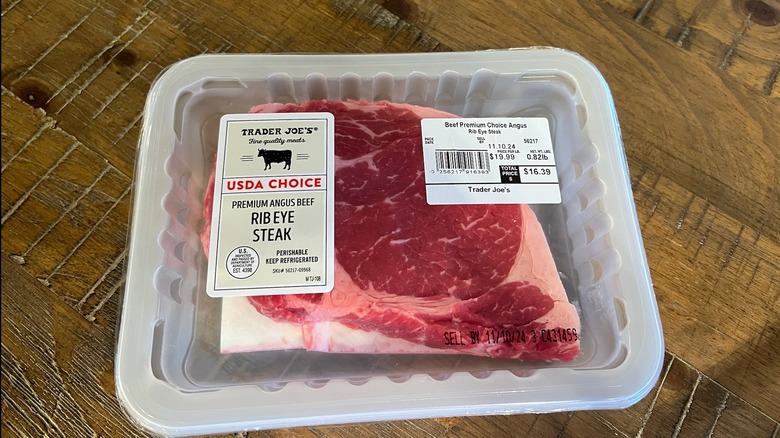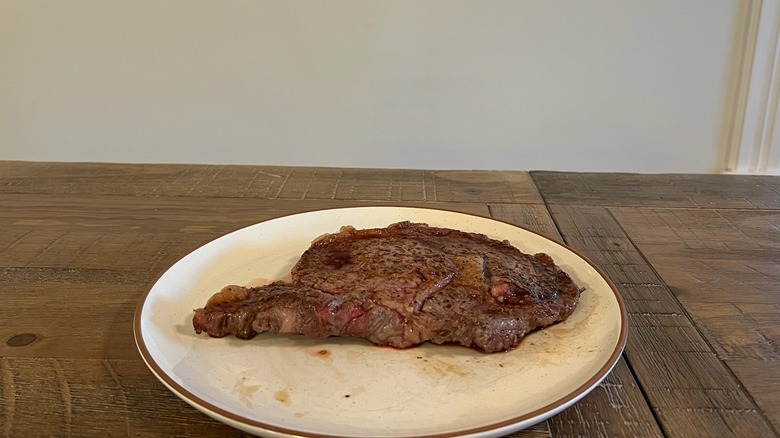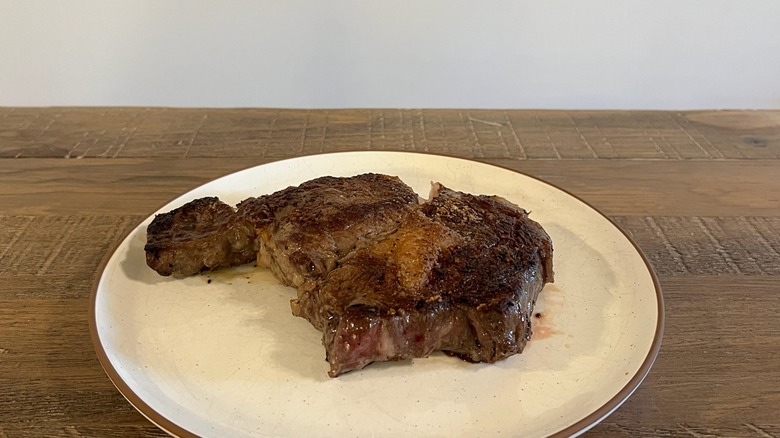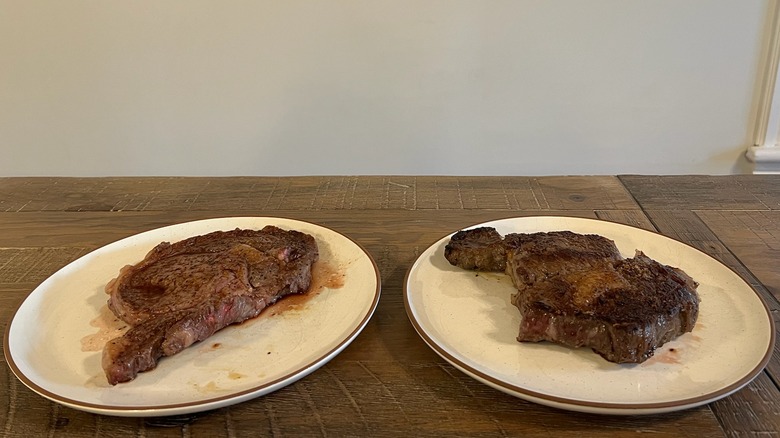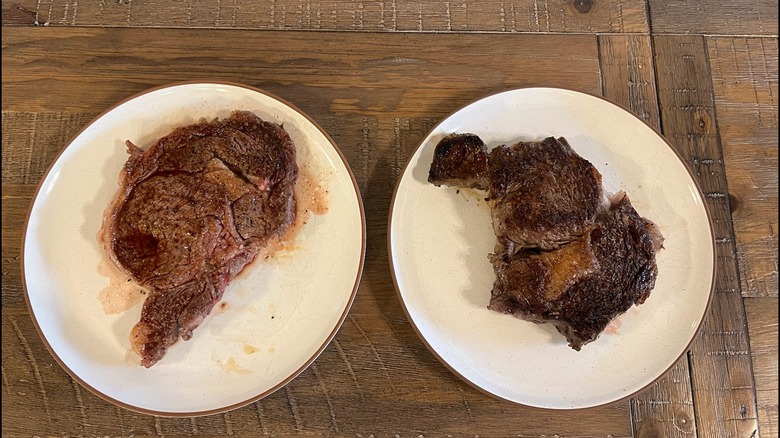Costco Vs Trader Joe's: Which Store Sells The Best Ribeye Steak?
When it comes to getting steak from a grocery store, sometimes it feels like you just never know what you're going to get. The quality and taste of a steak can be affected by many factors, including sourcing origin, whether or not it ever gets frozen, how it gets packaged, and more. Two of the most popular stores to get great food at an affordable price are Costco and Trader Joe's — and I was extremely curious to see how its steaks stacked up against each other.
I chose to go with a ribeye for my steak comparison. A ribeye cut comes from the rib section of a cow. The meat that is found in that part of the animal generally has a good amount of fat, which helps to make this cut of meat particularly tasty. It's a steak that is commonly sold in steakhouses across the world simply because it generally has a consistently great taste.
For my taste test, I cooked the ribeyes to perfection, preparing both steaks in the same way. I salted each cut with salt and pepper, and cooked them on a cast iron skillet. On high heat, I let them cook until they were medium-rare. After allowing the steaks to rest for about ten minutes, I dove right in. This taste test definitely helped me learn more about the difference in ribeyes available at both Costco and Trader Joe's, and I hope it helps you, too.
Price and availability of both ribeyes
A shopping trip at both Trader Joe's and Costco can be a bit of a "to do". They tend to have long lines, maneuvering the store can be a tad difficult when dodging tons of shoppers, and many people don't go to either store if they're just picking up one item. In my experience, however, both stores tend to have a consistently great food selection, so when I head to the store with a few specific things in mind, I always leave with it secured.
The Trader Joe's ribeye was priced at $16.39 for the cut, which was about 12.6 ounces. Per pound, the ribeye at Trader Joe's is about $19.99. Costco, on the other hand, only sells in bulk. The cheapest pack of ribeye that I found was for four pieces, and the total was $86.82. Each cut of ribeye was about 16.5 ounces, and the price per pound was $16.99. Costco provides much more bang for your buck, but not many people want to buy multiple pounds of meat in one go.
With a three-dollar difference per pound between the two stores, the difference is not that stark. Both are readily available in the store, and it's really up to the shopper whether they want to buy in bulk or grab a single ribeye.
How does Costco source and package its ribeye?
Neither the Costco website nor the store itself provides much information on where its meat comes from. I did a bit of digging to get as much information as I could. It's said that Costco gets its meat from multiple national suppliers. A Costco customer who is a big fan of the meat sold at the store wanted to learn more about where Costco gets its beef from, and learned that it actually gets meat from the same suppliers as Sam's Club. The reason there is a difference in the meat quality between the two stores, however, is because Costco actually tenderizes the meat with a blade tenderizer. These tenderizers sever the muscle tissue in the meat, making it easier to chew and more tender overall. I could even see "blade tenderized" written on the package of ribeye that I picked up.
The meat is packaged in four ribeyes on a styrofoam tray, vacuum sealed with clear plastic. The ribeye that I picked up had "USDA Prime" labeled on the front, which is the highest grade that the United States Department of Agriculture can give to a piece of meat. According to the USDA, prime meat comes from cattle that are young and well-fed. The meat will also have a large amount of marbling, which will help to give a steak delicious flavoring.
How does Trader Joe's source and package its ribeye?
Trader Joe's isn't necessarily transparent about where it sources its meat. Since there isn't any clear information about who the suppliers are, we can safely assume that Trader Joe's also receives its beef from many different national suppliers.
Trader Joe's doesn't carry many name brand items, and instead, it carries products under its private label. The beef is under Trader Joe's private label, and according to the FAQ on the Trader Joe's website, that means a few things. The meat will contain no artificial preservatives and no genetically modified ingredients. The FAQ also states that it provides options for beef that contain antibiotics and others that are organic. The ribeye that I picked up wasn't labeled as organic, so I'm going to assume it did indeed contain antibiotics.
The Trader Joe's ribeye is labeled as USDA Choice on the package, which means that it is still high-quality beef, however, it has less marbling as USDA Prime. The ribeye is packaged in a vacuum-sealed container with clear plastic. This way, I could look at each ribeye and pick out the one that looked the best.
Taste test: Trader Joe's ribeye
The Trader Joe's ribeye cut was much thinner than the Costco cut. When looking at the piece raw, I noticed that it did have a good amount of marbling throughout. However, the color of the steak was more of a pale red as opposed to the vibrant red color that steaks generally have. This definitely made me curious to see if the steak was as flavorful as a ribeye should be.
Once cooked, this ribeye cut did still have a few chunks of fatty pieces that I cut away. I avoid eating the fat from a steak because the texture isn't enjoyable to me. Once I got the fat away, I went ahead and dove in. The flavor was incredibly tasty, definitely surprising me a bit. Although I would say that the flavors were lighter than the Costco steak, it still had an amazing flavor that was easy to enjoy. The salt and pepper worked perfectly with the cut, as it helped compliment the natural flavors in the steak. There was a great buttery quality in the ribeye that I noticed as well. This ribeye was easy to chew, fairly juicy, and full-bodied without being overwhelming.
I would pick up this steak cut at Trader Joe's again. For a 12.6-ounce portion priced at $16.39, it's a pretty fair deal.
Taste test: Costco's ribeye
The Costco ribeye was much thicker than the Trader Joe's. It also had a darker red color and quite a bit more marbling. Just by looking at this cut of ribeye, I thought that it looked like it would be incredibly tasty and filling. I was curious to see if my preconceptions were right.
This ribeye had a few less fatty pieces than the Trader Joe's steak had, which was definitely a plus for me. It also crisped up nicely on the outside, more so than the TJ's. As I took my first bite, I definitely experienced an explosion of flavor. It was incredibly juicy, and I think the fact that the cut was so thick helped with that. The flavor felt like it was filled with more depth. I could taste the deep steak flavor very clearly, and it was extremely buttery.
The aspect of the Costco ribeye that I enjoyed the most was that the flavor stuck around on the tongue once you were done with a bite. The flavors were so intense and full-bodied that it completely overwhelmed the palette. Personally, when I'm craving a good steak, that's what I want to get out of it. This Costco steak really felt like I was eating a nice, real quality steak — something I would buy in a restaurant. The ribeye definitely lived up to the expectations of a prime cut of meat.
Which is better?
After tasting the Trader Joe's and Costco ribeyes, I definitely noticed some major differences. While they were both delicious, I think one easily outranks the other. Overall, the Trader Joe's ribeye had a lighter and milder flavor. The cut was thinner and less filling, and by pound, it was actually more expensive. The Costco ribeye had a much richer, deep flavor that was incredibly enjoyable. It crisped up much more than the Trader Joe's ribeye, and it was much thicker. The thickness led to more juice in the steak, which helped with the flavor.
Buying both of these steaks is a very different experience. With Trader Joe's, you can buy a single cut of meat and move on. With Costco, you have to commit to buying four large ribeyes in one go. For a single person, the Trader Joe's ribeye might be the easier choice. For a family, Costco is much more cost effective and convenient.
Ultimately, I think Costco wins this taste-off. It simply offered a better ribeye all around — taste, price, consistency, and overall experience led me to this decision. Although I tend to find shopping at Trader Joe's much easier for my lifestyle, I am planning on getting the Costco ribeyes when I am craving a deliciously high-quality steak but don't want to pay restaurant prices.
Methodology
For this taste test, I chose the best-looking ribeye steaks available at Trader Joe's and Costco. I paid attention to marbling and size while picking and brought home the best options. I seasoned each steak with equal amounts of salt and pepper. I then cooked the steaks on a cast iron skillet until they were medium-rare.
To keep the taste test fair, I waited until each steak was done cooking (keeping them warm with foil) and tasted them side by side. I took one bite after another, carefully comparing the qualities I noticed in each steak. I focused primarily on finding the steak that was most enjoyable and satisfying. Taste profile, consistency, juiciness, and mouthfeel all affected my ranking.
